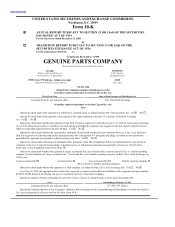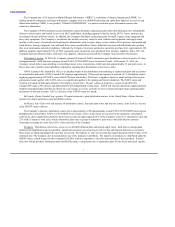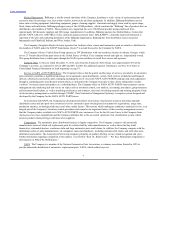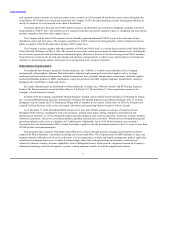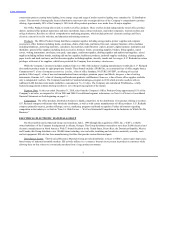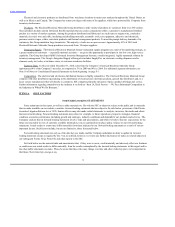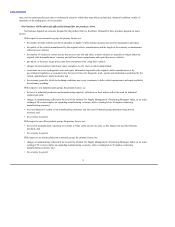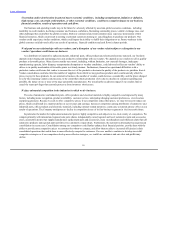Napa Auto Parts 2010 Annual Report Download - page 10
Download and view the complete annual report
Please find page 10 of the 2010 Napa Auto Parts annual report below. You can navigate through the pages in the report by either clicking on the pages listed below, or by using the keyword search tool below to find specific information within the annual report.
Table of Contents
time, and we cannot predict such risks or estimate the extent to which they may affect our business, financial condition, results of
operations or the trading price of our securities.
Our business will be adversely affected if demand for our products slows.
Our business depends on customer demand for the products that we distribute. Demand for these products depends on many
factors.
With respect to our automotive group, the primary factors are:
• the number of miles vehicles are driven annually, as higher vehicle mileage increases the need for maintenance and repair;
• the quality of the vehicles manufactured by the original vehicle manufacturers and the length of the warranty or maintenance
offered on new vehicles;
• the number of vehicles in current service that are six years old and older, as these vehicles are typically no longer under the
original vehicle manufacturers’ warranty and will need more maintenance and repair than newer vehicles;
• gas prices, as increases in gas prices may deter consumers from using their vehicles;
• changes in travel patterns which may cause consumers to rely more on other transportation;
• restrictions on access to diagnostic tools and repair information imposed by the original vehicle manufacturers or by
governmental regulation, as consumers may be forced to have all diagnostic work, repairs and maintenance performed by the
vehicle manufacturers’ dealer networks; and
• the economy generally, which in declining conditions may cause consumers to defer vehicle maintenance and repair and defer
discretionary spending.
With respect to our industrial parts group, the primary factors are:
• the level of industrial production and manufacturing capacity utilization, as these indices reflect the need for industrial
replacement parts;
• changes in manufacturing reflected in the level of the Institute for Supply Management’s Purchasing Managers Index, as an index
reading of 50 or more implies an expanding manufacturing economy, while a reading below 50 implies contracting
manufacturing economy;
• the consolidation of certain of our manufacturing customers and the trend of manufacturing operations being moved
overseas; and
• the economy in general.
With respect to our office products group, the primary factors are:
• the level of unemployment, especially as it relates to white collar and service jobs, as this impacts the need for business
products; and
• the economy in general.
With respect to our electrical/electronic materials group, the primary factors are:
• changes in manufacturing reflected in the level of the Institute for Supply Management’s Purchasing Managers Index, as an index
reading of 50 or more implies an expanding manufacturing economy, while a reading below 50 implies contracting
manufacturing economy; and
• the economy in general.
9

